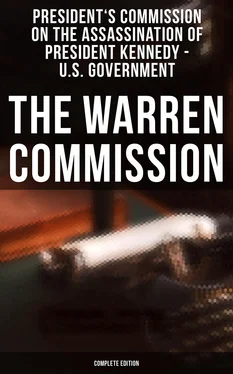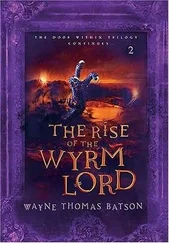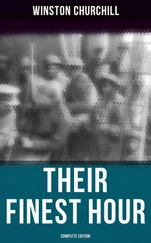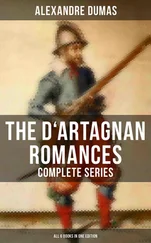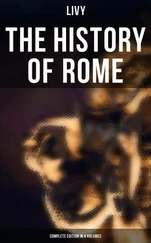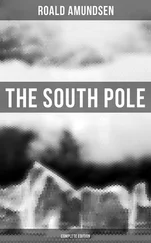Mrs. Oswald. I also don't know.
Mr. Rankin. Mrs. Oswald, I will ask you, on Exhibit 95, can you identify the handwriting on that?
Mrs. Oswald. It is Lee's handwriting.
Mr. Rankin. And did you ever see the pages of that Exhibit 95 as a part of his papers and records?
Mrs. Oswald. No. Perhaps I saw them, but I don't remember them.
Mr. Rankin. But you know it is his handwriting, where the handwriting appears?
Mrs. Oswald. Yes.
Mr. Rankin. We offer in evidence Exhibit 95.
The Chairman. It may be admitted.
(The document referred to was marked Commission Exhibit No. 95, and received in evidence.)
Mr. Thorne. Exhibit 96 is a photocopy of two pages that are handwritten and in English.
Mrs. Oswald. I also don't know what that is. For me, that is a dark forest, a heap of papers.
Mr. Rankin. With regard to Exhibit 95 that has been received in evidence, I should like to inform the Commission that that is also material concerning the book, regarding conditions in Russia.
Mrs. Oswald, will you tell us with regard to Exhibit 96—do you recognize the handwriting on those pages?
Mrs. Oswald. This is all Lee's handwriting.
Mr. Rankin. We offer in evidence Exhibit 96.
The Chairman. It may be admitted.
(The document referred to was marked Commission Exhibit No. 96, and received in evidence.)
Mr. Rankin. Exhibit 96 purports to be notes for a speech or article, on "The New Era."
Mr. Thorne. Exhibit 97 is a photocopy of several pages, both printed and in writing, handwriting.
Mrs. Oswald. It is amazing that Lee had written so well.
Mr. Rankin. Do you recognize the handwriting?
Mrs. Oswald. Yes, I do.
Mr. Thorne. This is also in English.
Mrs. Oswald, you state he had written so well. By that you mean what?
Mrs. Oswald. Neatly. And legibly.
Mr. Rankin. I offer in evidence Exhibit 97.
The Chairman. Exhibit 97 may be admitted.
(The document referred to was marked Commission Exhibit No. 97, and received in evidence.)
Mr. Thorne. Exhibit 98 is three photocopy pages of handwriting in English.
Mrs. Oswald. I don't know what that is.
Mr. Thorne. Do you recognize the handwriting?
Mrs. Oswald. That is Lee's handwriting.
Mr. Rankin. Exhibit 97 appears to be a critique on the Communist Party in the United States by Lee Oswald.
The Chairman. It may be admitted.
Mr. Rankin. We offer in evidence Exhibit 98.
The Chairman. It may be admitted.
(The document referred to was marked Commission Exhibit No. 98, and received in evidence.)
Mr. Rankin. Exhibit 98 purports to be notes for a speech.
Mr. Thorne. Exhibit 99 is one photocopy page of handwriting in English.
Mrs. Oswald. I don't know what that is.
Mr. Thorne. Is this Lee's handwriting?
Mrs. Oswald. Yes.
Mr. Rankin. We offer in evidence Exhibit 99.
The Chairman. It may be admitted.
(The document referred to was marked Commission Exhibit No. 99, and received in evidence.)
Mr. Thorne. Exhibit No. 100 purports to be four pages, photocopy pages, of handwriting, in English.
Mrs. Oswald. Lee's handwriting. But what it is, I don't know. I am sorry, but I don't know what it is.
Mr. Rankin. We offer in evidence Exhibit 100.
The Chairman. It may be admitted.
(The document referred to was marked Commission Exhibit No. 100, and received in evidence.)
Mr. Rankin. I wish to inform the Commission that this purports to be answers to questionnaires, and shows two formats, one showing that he is loyal to the country and another that he is not so loyal.
Mr. Thorne. Exhibit 101 is a photocopy of one page which is printed and handwritten in English.
Mrs. Oswald. Lee's handwriting. But what it is, I don't know.
Mr. Rankin. We offer in evidence Exhibit 101.
The Chairman. It may be admitted.
(The document referred to was marked Commission Exhibit No. 101, and received in evidence.)
Mr. Rankin. This purports to be a portion of the diary and relates to his meeting at the Embassy on October 31, 1959.
Mr. Thorne. Exhibit 102 is photocopies of two pages, handwritten, in English.
Mrs. Oswald. Lee's handwriting. I don't know what it is.
Mr. Rankin. We offer in evidence Exhibit 102.
The Chairman. It may be admitted.
(The document referred to was marked Commission Exhibit No. 102, and received in evidence.)
Mr. Rankin. I wish to call the Commission's attention to the fact that Exhibit 102 purports to be a draft of memoranda, at least, for a speech.
Mr. Thorne. Exhibit 103 is two pages, two photocopy pages, of handwriting, in English.
Mrs. Oswald. From the address I see that it is a letter—it is Lee's letter, but to whom, I don't know.
Mr. Rankin. I offer in evidence Exhibit 103.
The Chairman. It may be admitted under that number.
(The document referred to was marked Commission Exhibit No. 103, and received in evidence.)
Mr. Rankin. I wish to call the attention of the Commission to the fact that Exhibit 103 is a purported draft of the letter that Lee Oswald sent to the Embassy, the Soviet Embassy, which you will recall referred to the fact that his wife was asked by the FBI to defect—had such language in the latter part of it. This draft shows that in this earlier draft he used different language, and decided upon the language that he finally sent in the exhibit that is in the record earlier. The comparison is most illuminating.
Mr. Thorne. Exhibit 104 is photocopy pages of a small notebook.
Mrs. Oswald. This is my notebook, various addresses—when I was at the rest home, I simply noted down the addresses of some acquaintances.
Mr. Dulles. Is this in Russia, or the United States?
Mrs. Oswald. In Russia.
Mr. Rankin. We offer in evidence Exhibit 104.
The Chairman. It may be admitted.
(The document referred to was marked Commission Exhibit No. 104, and received in evidence.)
Mr. Thorne. Exhibit 105 is a notebook——
Mr. Rankin. Exhibit 104 purports to be a small notebook of Mrs. Oswald.
Mr. Thorne. Exhibit 105 is the original of a notebook containing various writings in English and in Russian.
Mrs. Oswald. This is when Lee was getting ready to go to Russia, and he made a list of the things that he wanted to buy and take with him.
Further, I don't know what he had written in there.
Mr. Dulles. Was this the time he went or the time he didn't go?
Mrs. Oswald. When he didn't—when he intended to.
Mr. Rankin. In Exhibit 105, Mrs. Oswald, I will ask you if you noted that your husband had listed in that "Gun and case, Price 24 REC. 17."
Mrs. Oswald. I don't know what that is. Unfortunately, I cannot help. I don't know what this means.
Mr. Rankin. But you do observe the item in the list in that booklet, do you?
Mrs. Oswald. Yes.
Now I see it.
Mr. Rankin. I offer in evidence Exhibit 105.
The Chairman. That will be received.
(The document referred to was marked Commission Exhibit No. 105, and received in evidence.)
Mr. Rankin. With regard to Exhibit 102, I should like to inform the Commission that as a part of this transcribed record, as soon as we can complete it, we will have photostatic copies of these various exhibits for you, along with photographs of the physical material. But I think you will want to examine some of it very closely.
I call your particular attention to this draft of a proposed speech. One of the items, No. 1, states, "Americans are apt to scoff at the idea that a military coup in the U.S. as so often happens in Latin American countries, could ever replace our government. But that is an idea that has grounds for consideration. Which military organization has the potentialities of exciting such action? Is it the Army? With its many conscripts, its unwieldy size, its score of bases scattered across the world? The case of General Walker shows that the Army at least is not fertile enough ground for a far-right regime to go a very long way, for the size, reasons of size, and disposition."
Читать дальше
